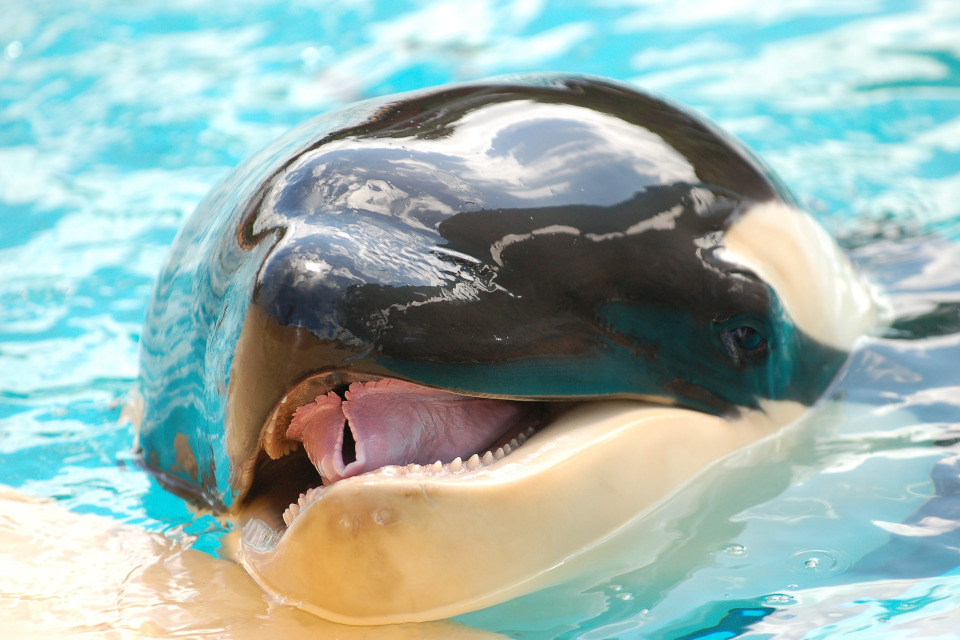Written on the 5th of April in 2019. | Author: Robin De Vries, Pre-Production: Sander Gielen, Editing for zoos.media: Philipp J. Kroiß
After her first article, the author visited orca Morgan again and met her daughter Ula. She describes her observations and interviewed the experts in Loro Parque.
Baby Ula: Healthy and Happy
Who is Ula?
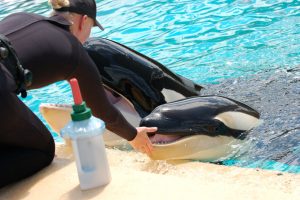
Ula is a female killer whale of orca located at Loro Parque Tenerife located at the Canary Islands. She was born on September 22, 2018 to the orca named Morgan who is pretty well-known and sparked a lot of controversy around the globe, as did Ula’s birth. Morgan is a female killer whale or orca (Orcinus orca) that was rescued by Dolfinarium Harderwijk, a Dutch Marine park on June 23 2010 after being found alone and extremely malnourished in the waters of the Wadden Sea.
She was completely emaciated when she came to the Dutch dolphinarium. Despite her condition and thanks to the care of the staff and experts at Dolfinarium Harderwijk she recovered rapidly. It was decided Morgan would not be able to survive in the wild by several independent experts unless her exact family group (or pod) was found. Several efforts were made to match photos, her sounds and even her DNA with the existing orca groups who were studied in the wild. Sadly an exact match wasn’t found. At this point it was time to find a new home where Morgan could stay in permanent rehabilitation. Loro Parque was found to be suited for this as they had a suited habitat with several other orca’s where Morgan could be integrated into a group of her own kind.
The intention to keep her in captivity caused a lot of controversy around the world and is currently still a very sensitive topic to many. Several animal rights groups stood up and questioned the marine park’s intention, The Free Morgan Foundation being one of the main groups playing a part in this. Protests ensued and became bigger and more violent. Even threats were made to the park and its employees as they were accused of being animal abusers and murderers. Despite this they gained a lot of followers and eventually even took to court. The outcome of this (and several other court cases filed after that) was again that Morgan would not be able to survive in the wild. The last one being settled only last month, again in Loro Parque’s favor. The protests and negative press never stopped however, even after the the move to Loro Parque which took place on November 29, 2011.
Today Morgan resides at Loro Parque, where she participates in research as well as shows and education. During her stay in Loro Parque it was discovered Morgan has a hearing impairment. Already before she came to Loro Parque her caretakers suspected Morgan might have had hearing problems as she was unresponsive to sounds. Several different occasions of hearing tests and acoustic research have been done since she arrived in Loro Parque which confirmed Morgan is actually deaf. This turned out to be an even bigger argument that she would be unable to survive in the wild as well as a possible reason why she might have lost her original pod in the first place. On December 3, 2017 it was confirmed to the public that Morgan was pregnant. For more information on Morgan’s story, Loro Parque and Morgan’s pregnancy I recommend reading my previous article.
Pregnancy and birth
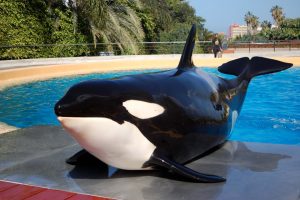
On September 22 the day was finally there; Morgan gave birth! The calf was large, appeared active and strong and soon showed nursing behavior. All seemed well and perfect. Morgan displayed good maternal instincts and behavior as well. Everything the staff had hoped! Soon however, they noticed that the nursing behavior was not totally normal. Ula seemed to have problems nursing and after a while she started to lose weight. This was a sign for the caretakers that something was wrong. The cause was soon found: Morgan produced little to no milk of her own. It was decided to step in and separate Ula from Morgan to assure her survival. She was bottle-fed with milk formula and the little milk that Morgan did produce was added to the mixture. It was a difficult decision but ultimately it had to be made to save Ula’s life.
In the last years I have been to Loro Parque myself numerous times to witness the status and treatment of Morgan, both behind the scenes as well as a normal visitor. Of all these instances I wrote articles and blogs about my findings. I have yet to conclude any of the accusations mentioned above. In 2018 I visited Morgan together with another colleague who is also in animal care and we wrote an article about her pregnancy. The goal was to see how Morgan was doing, interview her caretakers and observe her daily care. From October to March I observed Morgan and Ula with the same intentions. I visited both behind the scenes and as a normal visitor to form a honest perspective and opinion. The following is a report of the findings:
Ula was soon gaining more weight. I was there in October when they had recently been separated. At this time the staff had to hold Ula in place for the feeding sessions. She appeared active and healthy. Swimming fast and porpoising her head high out of the water. She also put her tail out of the water and spyhopped to see her surroundings. Morgan and Ula were able to communicate through the gates of the tank system and did so. Morgan was usually kept in the right side pool and would check up on Ula regularly. She also however would swim around, play with enrichment and socialize with the other orcas. She was in no way obsessively hanging near the medical pool were Ula was kept. Morgan did not have to participate in shows during this period, but could choose to do so. I saw her doing small segments of shows, usually one per day. This way she could stay enriched and spend a lot of time near her calf.
Ula grew very rapidly both physically and mentally. She started approaching the trainers herself for feeding sessions and her health became more stable. As the situation was under control Morgan and Ula were reintroduced to each other. First only in very short sessions until finally in January they were permanently together again. This was a victory for the entire team as it was the main goal to have mother and calf together again as soon as possible. Morgan and Ula bonded again straight away and communicate and interact with each other ever since. Ula has even begun with the basics of training, which makes it easier to feed her, take care of her and perform medical care and examinations. Copying Morgan is a big part of this training, but Ula has also developed an amazing bond with her caretakers in the time they have been taking care of her.
Interview
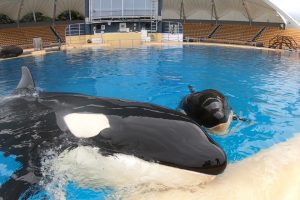
As with the last article I interviewed some of her caretakers, aswell as Dr J. Almunias to get some more information and clarifications about Ula. Several press releases have been featuring the young orca as well as claims by activists that she is not doing well at all. To get a better perspective on the situation I subjected the staff to the following questions:
How is Ula doing at the moment?
She’s doing really well actually, She displays positive behavior, no signs of discomfort, she’s growing, active, and now establishing a link between her and mother.
Why was Ula separated from Morgan soon after birth?
We realized that the nursing was abnormal from the beginning. After a while we found out Morgan did not produce enough milk. This was because Ula seemed to be losing weight. So the decision was made to keep them together for as long as we could, trying to extract milk from Morgan. However soon we noticed that that still wasn’t enough. We were prepared for this situation and already had milk formula, which mixed with the very little milk Morgan did produce. We Don’t regret the decision as this saved Ula’s life. So it was for her own health and benefit.
When did You decide to step in?
As said above. With some mammals it can take a while before the milk production starts and the offspring can normally handle that. But when Ula started to lose weight we made the decision. Morgan is a first time mother, so in the beginning there was hope. But by amount and time of nursing we saw and the weight loss, we decided it was necessary to step in. Ula needed to be in the medical pool so it was easier to feed and treat her. This is the reason Morgan and her had to be separated. Because it was out of protocol and possibly dangerous to have Morgan in the same pool when trainers had to enter the water for the feeding sessions. In the end it was the only choice for the wellbeing of both.
How did Morgan respond to this separation?
Morgan is familiar and with has confidence in the trainers and the team, So she responded calmly and not very obsessive over Ula at all. They could still see and hear each other and interact with each other.
How did Ula respond to the separation?
Ula responded well, she responded good to her trainers from the start who were there 24 hours a day. Because she was losing weight and therefore hungry she accepted the bottle right away and soon made the link that the trainers were a way of getting food. She was really calm with the entire situation. Some trainers had to work extra shifts and a team of caretakers and extra veterinarians constantly ensured her wellbeing.
Can you tell us a bit about the care Ula got as a neonate? Which steps were taken etc.?
We already had a lot of experience with young calves and bottle-feeding. Therefore the steps made were logical and she got the optimal care.
How was the reintroduction with Morgan? this is asked a lot, how did they both respond?
This went exceptionally well for both of them. For Ula it was very enriching, she was with trainers most of her life at this point, so reintroduction with her mother was great. She is really playful and interactive with Morgan. It has also been good for Morgan. She is really energetic, active and strong. When Ula is there however she calms down. Although the bond is a bit different then when she would have been with Morgan from the start there is lot of affinity between them. They reconnected right away and it has remained a really strong and good connection ever since.
Can you tell us more about the infection Ula suffered?
She had an infection which showed as an irregular skin patch on the right flipper. This happened when she was 1 month old. Due to our observant staff it was treated right away and completely healed. The flipper looked a bit off still and was posted online by animal activists but at this point it was already completely healed. It isn’t anything of concern and even common among cetaceans. The excellent care by our staff made it possible to detect and treat this early. It happens more often that small wounds (Like Morgan and the small wound on her rostrum) get blown up and taken out of context by animal activists online.
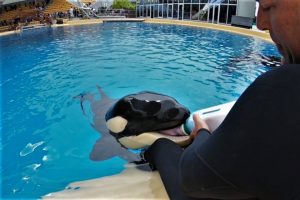
Does Ula respond well to trainers?
She is responding great to her trainers and caretakers from the beginning. Ula is already starting to being trained now. This is the most positive and enriching link between her and her trainers. It is positive reinforcement to her and she completely trusts the trainers because they are the one that fed her almost her entire life at this point.
Can you tell a bit more about Ula’s training?
It’s very complex because doesn’t feed on fish yet. The trainers know what she likes most of all; scratching. This is being used as her positive reinforcement. So no food motivation is used for her training and everything is based completely on secondary reinforcement. She needs to be weighed once a week. Since she cannot slide up on the scale yet, she is weighed in a sling. During this procedure she is calm cause it’s all very positive situation for and she has been doing it from the beginning of her life.
The most important focus is to train for medical treatments and checkups for her health. For example: voluntary blood sample, presenting her body. When the fish is introduced in her diet this will be used as a primary positive reinforcement. This is the most important time for a calf to learn. She copies a lot from Morgan which is the natural way of learning for a young mammal.
Has Ula been introduced to any other orcas at the moment?
Not for now. Our first focus was reestablishing the link with her mother. After that we can look into which individual is best to introduce her to. (Most likely Adán). Usually this will start after 1 year of age, similar to Adán. We will have to use caution when introducing her to the group as to not disturb and respect the hierarchy.
Does Ula have any hearing impairment like her mother?
We think that her hearing is ok because she is responding to whistle, so we know she can hear. Later test will have to provide to what extent. This does however mean that Morgan was mostly likely not deaf from birth, as the deafness does not seem to be genetic. We also recorded Morgan and found out she uses Norwegian orca sounds, which means she at one point in her life heard these to imitate them.
Is Ula’s father known yet?
Not yet. We are testing this though. We need to look at the primary visible points that match between Ula’s DNA and all the males in the group. For now we need to ensure Ula’s health and that is most important to us and our main focus. The father we will determine later.
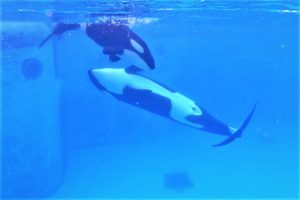
What do you have to say about the accusations of animal activists regarding Ula’s skin and head shape?
The skin was as earlier mention a form of infection and already completely healed. She has a flat head shape, compared to other animals, but not all animals have all the same head shape. In our group alone we have so many different ecotypes of orcas that the appearance will vary in any calf. Activists compare this to a peanut head (sign of malnourishment) but that is certainly not the case. Her weight is normal, even larger than Adán at this age! She is growing well and steadily. We think activists always try to find something negative to talk about our park.
How was her name chosen? Does it have a special meaning?
It means something which translated comes down to “Jewel from the sea”. Which is similar to the meaning of Morgan’s name. The management chose this name out of several. It was important for everybody in the company that she received a fitting name as she was and is one of the most popular animals at the park.
Is there any scientific research done with Ula at the moment and/or in the future?
From the very beginning we placed a recorded and recorded on solid memory every sound that Ula made. The goal was to see what sounds she makes and at what age orcas start to use echolocation. This research is still being done. We also want to know how the development of dialect is going since Morgan has an unusual vocabulary. So we want to learn if she is going to pick up the dialect from the group or just Morgan, perhaps even both. We have all the resources to execute research. There is not much more we can study right now as she is very young.
Are there any abnormalities with Ula, her health or her growth whatsoever?
She is matching Adán’s weight at this age, even a little heavier. There is no concern for her health and our veterinarians are keeping a close eye on her. She is active, eats a lot, and grows in a good rate. Everything is going well at the moment and there is nothing abnormal about her health or growth.
Why were there so little press releases at the beginning?
We have over 10.000 animals in the park. Ula is very important and orcas are not so common in captivity, but for us she is just like any other newborn animal in the park. So we did not see the need of putting out more news than usual. Also the medical health and her wellbeing were more important at that time. At the moment a lot of pictures, videos and updates are posted about her. This is already much more then we usually do with a young animal. She was doing well and publishing this over and over again was just not logical to us. Such an active communication of one single animal in a whole collection is not common. “So if there is no news, you do not communicate the absence of news”
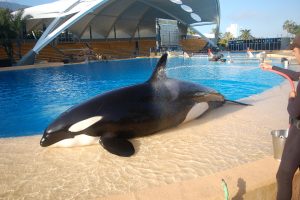
Is Morgan an exemplary mother?
From the beginning Morgan was a really good mother for the calf. This was of course very exciting as it was her first calf and even in the wild the first calf typically has a lower survival chance. Orcas do learn maternal behavior from other animals but we think instinct still plays a part. If in the wild everything depended solely on copying it would be difficult to reproduce successfully at all. Some pods in the wild are so scarce and small that not all young females still have a mother, grandmother or other relative to learn from. Also, learning is an experience that can go wrong as well. In many animals the first birth is risky and with Morgan it was the same. We are very happy everything went well and even now she behaves as an exemplary mother.
What does the (near) future hold for Ula?
At the moment the training will go on, she will follow the same learning curve of Adán ideally. She will be involved in group behavior when the time comes. Which means group swimming, training, presentations and everything the other orcas participate in.
The hierarchy will be shuffled when a new member enters the group. Ula will most likely start out as the lowest in the hierarchy since she is new. She might have a place higher up if the maternal link to Morgan plays a part. Morgan is currently placed quite high in the hierarchy. She rivals with Skyla for the second in place. Right now Morgan and Ula have a friendly bond, more so than a maternal bond. It would be interested to see if Ula gets a head start in the group because of the position of her mother or if she starts at the bottom of the hierarchy.
Observation
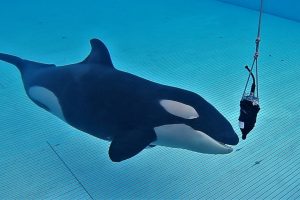
I visited Ula and Morgan behind the scenes to see how they were behaving and how they were being cared for. From the beginning I could see they have a strong bond and interact a lot with each other. They are almost always together unless there is a particular training session for which one of them needs to be separated (such as medical procedures). They do not share a very typical mother-calf bond as I have seen them with other orcas and marine mammals as Ula is already very independent and also swims on her own a lot. Most calves of this age I have observed follow their mother almost continuously. Ula however ‘draws her own plan’ on a lot of occasions. Approaching Morgan to play, jumping, testing her environment and swimming away from and to Morgan on her own.
This makes it so that the two have a very playful bond, yet there is a clear maternal bond as well. Ula also has a unique bond with her trainers and caretakers, more so than most orcas of this age. She loves to be touched and scratched by them and is very keen on getting attention from anyone who is nearby. What is unique with Ula is that she is trained and rewarded fully on secondary reinforcement. This means no food reward is given, which is normally pretty common in animal training. Ula however does not eat fish yet so all her rewards are a form of scratching, touching and attention. Something she absolutely loves according to her trainers. This contributes immensely with her training and medical check- ups, making everything as positive as possible for Ula and still being able to care for her in the most optimal way.
Findings
To me Ula appeared very active and alert. She swims very fast and breathes very powerful when she surfaces. She jumps and porpoises a lot. Sticks her tail in the air, spyhops and spits water at people. She approaches Morgan, plays with Morgan and is very tactile with her. Ula is focused on humans but not to the point where this is over obsessive. Ula and Morgan both play with the enrichment that is offered to them. Ula is especially playful and interactive. In short she appears like a normal young orca and appears healthy just as the park claims. I do not find her head shape to be abnormal as Morgan herself had a pretty long and flat head when she was younger. I observed this myself and took many photos of it. Her pectoral fin and flipper are also very smooth and do not seem abnormal. She is already shedding her orange/brown baby skin to
a more white or yellowish tone which causes some discoloration but this is of course completely normal for a growing young orca. As a visitor you can observe a lot of this behavior yourself as Ula is very visible from the visitor area. She now switches pools daily as well so when you are lucky you can see her from the left backpool very well when entering or leaving the stadium. I am pretty confident anyone who observes her from that area can confirm the things I saw and stated here. I recommend to go and see her as she has already grown so much! It’s already so much difference between October and now!
Epilogue
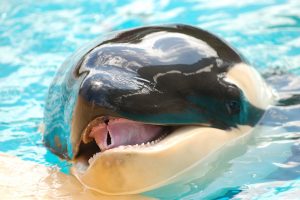
As with the findings and articles of the previous years the care of the orcas is exceptional. The animals all appear in an active and healthy state. There are many training sessions, play sessions and ‘free time’ sessions for the animals throughout the day. My observations and findings were not different on the days I chose to visit the park as a normal visitor. Which strengthens the claims even further. The transparency of Loro Parque and its staff as well as the dedication and care for their animals and nature in general speaks for itself. I did not find any negative aspects at all. To be completely honest I cannot even name a single one.
I highly recommend visiting the parks that have negative claims by animal rights activists and extremist yourself to make a conclusion of your own judgment. As someone who is in animalcare myself I can at least make some substantiated opinions, though I think even someone without much knowledge about animals can come to the conclusion the animals are well cared for and absolutely not abused. I respect there are different opinions on the topic of animal captivity, but claiming abuse and making false accusations is a very serious case that must not be taken lightly. Especially during the age of social media it very easy to put a facility in negative light and use false information, edited footage and false statements to force people into an opinion. This is simply not okay and not the right thing to do when trying to force your own agenda.
As in the last article I happy to conclude that the current accusations made by several animal right groups are once again wrong. Observe, educate yourself and above all: Protect nature and it’s animals in every way you can! I would like to acknowledge Mr. W. Kiessling, Mrs. N. Romashko and the Orca Ocean staff for creating the opportunity to stay and observe at Loro Parque, aswell as Dr. J. Almunia and the Orca Ocean professionals for the interview opportunities.
